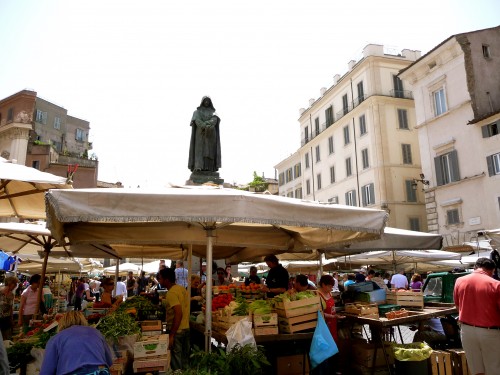
Shopping at a mercato {outdoor market}
One of the greatest pleasures in traveling to Italy is eating all the yummy Italian food, so you certainly don’t want to miss out because you got lost in translation.
Whether you’re renting an apartment and need to shop for provisions, wanting to pack a nice picnic lunch or just a foodie desiring to sample the traditional Italian food on offer, here are some common places to shop, along with their translations, and tips for purchasing whatever your mouth desires.
Mercato – This is the general term for a market. It usually applies to an outdoor market, which has set operating days. Some are open everyday, others once a week. Shop from morning to afternoon since they are not open in the evening.
Supermercato – This Italian term translates to—can you guess?—Supermarket. They carry a variety of Italian food products, from breads and pasta to meat, cheese, and dairy. A Supermercato in Italy is pretty similar to those in the United States, with a few important differences.
For hygienic reasons, you aren’t supposed to touch unpackaged food with your bare hands. Instead, you can use disposable gloves (usually found near produce bags). Also, it’s typically the shopper’s responsibility to weigh their produce on the provided electronic scales and attach the tags which print out, before getting to the checkout. And don’t expect anyone to bag for you. Not only is it customary to bag your groceries, but due to Italy’s outlaw of plastic bags in 2011, you might want to bring a reusable bag to avoid having to purchase one.
Alimentari – These are smaller, usually more locally based grocery stores with a little less variety. Here you can satisfy your most basic food needs.
Pasticceria – If you see a sign sporting this word, your sweet tooth should jump for joy. A Pasticceria is a pastry shop. They obviously carry pastries, but they can also carry cakes, sweet breads, coffee, candy and even gelato.
Panetteria or Panificio – These translate more or less to bakery. They specialize in the sale of freshly baked bread (pani). A panificio usually bakes and sells the bread, while a panetteria sells bread, but may or may not actually make it there.
Italy has over 350 types of bread which can include sweet bread and pizza. Bread can be sold by weight, loaves or half loaves. Sometimes you can order Panini or a panino (a roll used for sandwiches—panini can refer to the roll itself or a finished sandwich).
Rosticceria, Salumeria, and Macelleria – All three of these shops specialize in meat. The difference lies in what kind of meat they sell. A Rosticceria sells cooked or roasted meat. A Salumeria sells cured deli meats (think prosciutto, salami, mortadella). Though they sometimes carry deli meats, a Macelleria is typically more like a butcher shop. In Umbria, you’ll find a Norcineria, stemming from the town of Norcia, which is known for its cured meat.
You can purchase fresh red meat, poultry, pork and sausage. There’s quite a variety including things you wouldn’t normally find in the States like quail, pheasant, rabbit, donkey, and horse (a Macelleria Equina would only sell horse meat). These three typically don’t sell precut or prepackaged meat. You can ask for the type and weight you would like and it is cut or sliced fresh for you.
Pescheria – A fishmonger or fish shop, where you can buy fresh seafood. If, however, you don’t want to see what your fish looked like before it was on your plate, a pescheria may not be the place for you; usually a pescheria doesn’t sell precut fish fillets, instead the fish will be displayed completely intact. Ask for fish by weight or piece and they will clean and cut the fish for you (usually leaving the head on).
Latteria – A latteria sells dairy products, though they may not be the dairy products you’d find in an American grocery store. Though they can carry bottles of fresh milk in refrigerators, the milk can also be found unrefrigerated on shelves. This is because it’s processed at ultra-high temperatures and doesn’t require refrigeration before opening. Instead of finding milk in the refrigerated section you may find fresh pasta and a variety of cheeses.
Frutta e Verdura – These shops sell mainly fresh fruits and veggies. Like the Supermercato, remember that most have a “No Touch!” policy. When you greet the shop owner he or she may present you with a bag to fill or simply tell them what you want along with how many and they will fill a bag for you. If you’re using hand signals to communicate quantity, remember Italians count number one by holding up the thumb rather than the pointer finger. The rest of the numbers follow from there (for 2 hold up thumb and pointer; 3 is thumb, pointer and middle, etc.)
Gastronomia – Though food in Italy is usually made and eaten on the spot, a Gastronomia is a place to purchase a range of freshly prepared or ready-to-heat items like salad, pasta dishes, and sandwiches. They may also carry deli meat.
Hungry for more? Perhaps you’d be interested in a foodie adventure or food market tour in Italy.
Get in touch, I’d love to help!
Written by : Kelly Whelan
